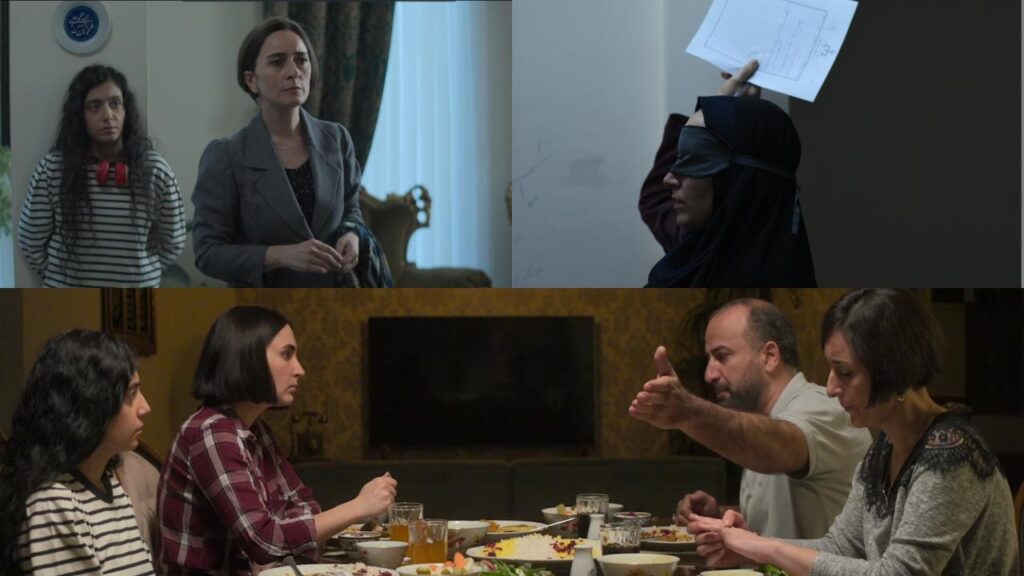by Hudson Moura
Mohammad Rasoulof’s The Seed of the Sacred Fig is a striking, ambitious drama that navigates the turbulent waters of family dynamics against the backdrop of Iran’s ongoing sociopolitical struggles. With a runtime of nearly three hours, the film weaves an intricate tale of a father, his daughters, and the moral dilemmas that arise when familial loyalty collides with political duty. Nominated for Best International Film at the Oscars, Rasoulof delivers a deeply nuanced narrative that refuses to conform to simple dichotomies of right and wrong.
A Family at the Heart of a Nation’s Struggle
At the center of the story is a father, recently appointed as a judge during a fraught moment in Tehran’s history, where women are boldly protesting against the hijab laws. Caught between his professional obligations and personal beliefs, the father must strictly enforce laws he may not fully support, especially under the scrutiny and pressure of his superiors. Yet, as he grows more rigid in his role, his two teenage daughters rebel against his authority, joining the wave of defiance sweeping across their schools and the streets.
The mother, caught in the crossfire, becomes a poignant figure of duality, empathizing with her daughters’ rebellion while struggling to maintain peace with her increasingly authoritarian husband. The daughters’ escalating defiance, including aiding a classmate who is later imprisoned, sets the stage for a complex power struggle within the family. The mother’s attempts to mediate only deepen the father’s frustrations, leading to a cycle of lies, manipulation, and aggression that mirrors the wider unrest gripping the nation.
Ambiguity and Moral Complexity

Rasoulof avoids moral absolutes, presenting characters who are neither entirely sympathetic nor outright villainous. Though harsh and authoritarian, the father is trapped by a system that forces him to comply. The daughters, though brave in their rebellion, weave a web of lies and manipulations that ensnare their family in deeper conflict. This moral ambiguity challenges viewers to grapple with the complexities of survival, resistance, and truth.
The film’s refusal to frame the conflict in black-and-white terms is one of its greatest strengths and, at the same time, weaknesses. It captures the tension between personal agency and systemic oppression, exploring how power and rebellion manifest in even the most intimate relationships. The father’s aggressive measures to enforce discipline are paralleled by the daughters’ increasingly bold acts of defiance, creating a layered dynamic where both sides are complicit in the escalating tension.
Interspersed with footage of real-life protests, The Seed of the Sacred Fig blurs the personal and political lines. The family’s struggle becomes a microcosm of a nation’s reckoning with authority, freedom, and identity. The analogies are compelling, though the framing of the story through the lens of a judge’s family is both unexpected and, at times, emotionally distant. While the narrative provides a fresh perspective on Iran’s sociopolitical issues, it occasionally struggles to maintain the audience’s engagement, as the characters’ roles as metaphors sometimes overshadow their emotional depth.
A Demanding Watch Requiring Full Engagement
The Seed of the Sacred Fig is not an easy film to watch, nor does it attempt to be. Its layered narrative, moral ambiguity, and deliberate pacing require emotional and intellectual investment from the viewer. Yet, it is precisely this complexity that makes the film so compelling. Rasoulof crafts a poignant reflection on power, resistance, and the cost of standing up for one’s beliefs by examining Iran’s sociopolitical landscape through the intimate lens of a family in crisis.
The film’s visual storytelling is striking, with Rasoulof’s keen eye for detail capturing the stark contrasts between the private world of the family and the chaotic protests outside. The scenes of unrest serve as both a backdrop and a constant reminder of the stakes at play, grounding the family’s turmoil in a broader societal context.
As the film progresses, the tension mounts inexorably toward an explosive and tragic conclusion. Rasoulof’s pacing, while deliberate, may test the patience of some viewers, but it rewards those willing to immerse themselves in its intricate narrative. The script’s moments of quiet introspection are punctuated by raw, emotional confrontations, creating a sense of mounting dread that culminates in a harrowing finale.
Bold Genre Choices: A Dystopian, Suspenseful Political Thriller
Rasoulof’s unconventional approach transforms what begins as a familial drama into a suspenseful thriller, defying expectations for a film so rooted in sociopolitical commentary. Specific sequences, particularly those set in the barren desert where the father confronts his moral and professional dilemmas, evoke the eerie atmosphere of a dystopian horror film. These moments feel deliberately cinematic, using stark, isolating landscapes and haunting sound design to amplify the psychological tension. With its oppressive silence and visual desolation, the desert becomes a space of reckoning—a liminal world where personal and political conflicts collide.
This genre-infused lens nods to the tradition of classical Hollywood political thrillers, blending high-stakes drama with moments of intrigue and suspense. By doing so, Rasoulof brings an unexpected layer of entertainment to a narrative deeply entwined with political conflicts and moral reasoning. This choice not only heightens the narrative tension but also makes the film accessible to broader audiences, inviting them to engage with Iran’s sociopolitical struggles in a way that resonates universally.
Though its emotional resonance may falter at times, and its nearly three-hour runtime can feel demanding, the film’s thematic depth and nuanced characters make it a standout work. The Seed of the Sacred Fig is a testament to Rasoulof’s ability to navigate the personal and political intersections, creating a film that lingers in the mind long after the credits roll.
 (4/5)
(4/5)